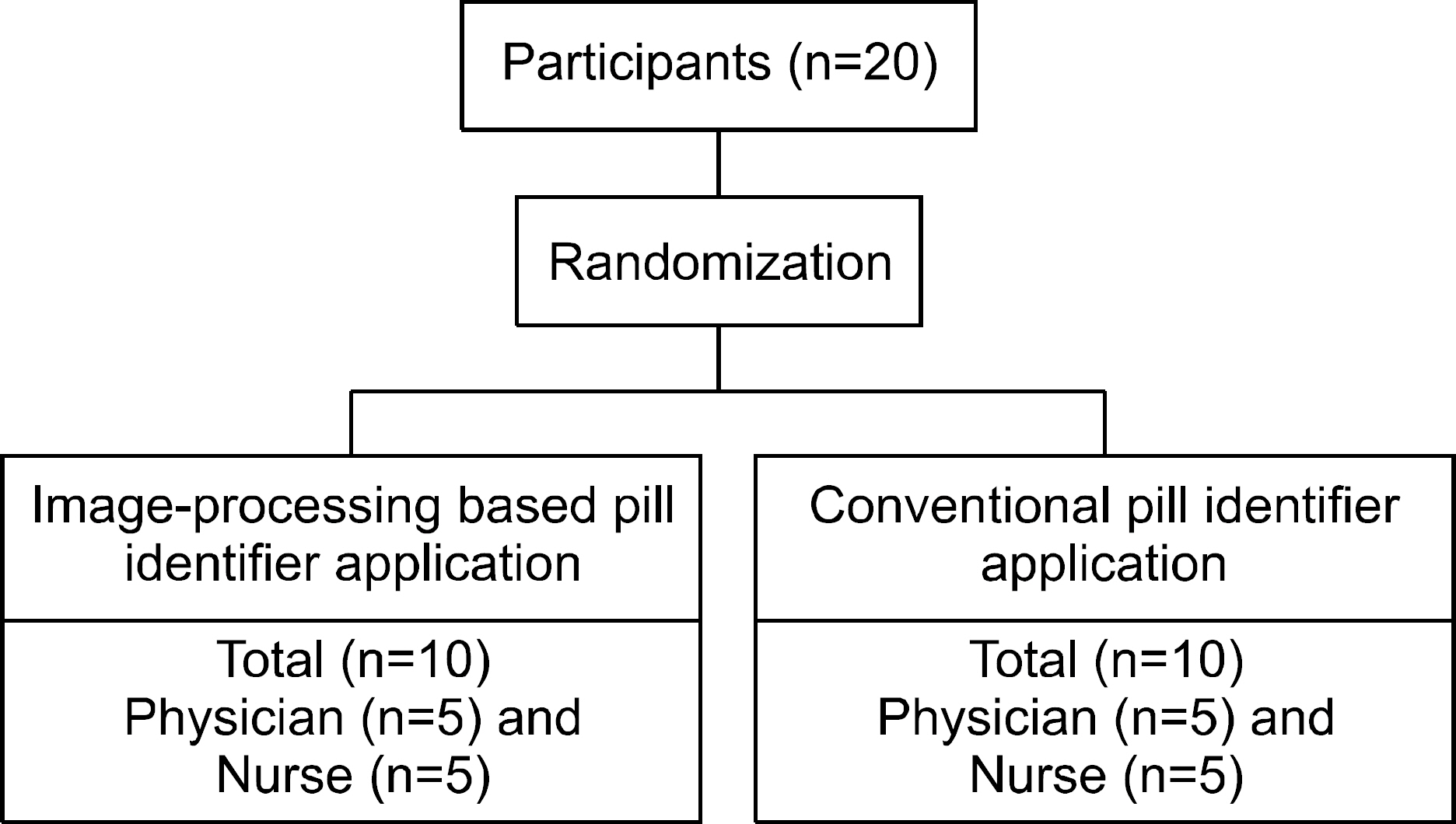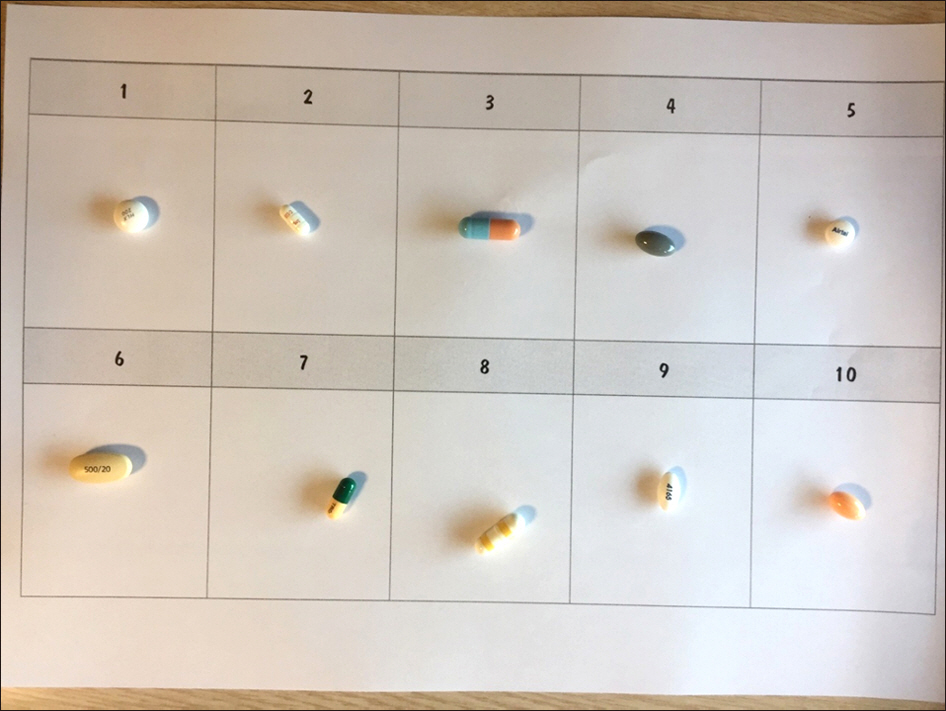J Rheum Dis.
2019 Apr;26(2):111-117. 10.4078/jrd.2019.26.2.111.
Usability Evaluation of an Image-based Pill Identification Application
- Affiliations
-
- 1Department of Rheumatology, Hanyang University Hospital for Rheumatic Diseases, Seoul, Korea. sungyk@hanyang.ac.kr
- 2Department of Arts & Technology, Hanyang University, Seoul, Korea.
- KMID: 2442021
- DOI: http://doi.org/10.4078/jrd.2019.26.2.111
Abstract
OBJECTIVE
To measure the accuracy and usability of an the image-processing based pill identifier application that we have developed.
METHODS
The subjects selected were medical residents and nurses. Five nurses and five physicians were randomly assigned to use either an the image-processing based pill identifier application (n=10), or the conventional pill identifier application (n=10). They were instructed to examine 10 pills using the application assigned to them, and searches that took <3 minutes to find candidate drugs were recognized as successes. Among these successful searches, the accuracy was defined to identify the correct names of the drugs and the times needed in the correctly identifications were also measured. After using one application the subjects were instructed to use the other one and repeat the same process. Finally, they answered a questionnaire on the usability of the applications.
RESULTS
The average proportion searches completed within 3 minutes was 91% for the the image-processing based pill identifier application, slightly, but not significantly, higher than that for the conventional pill identifier application (85%). The accuracies of the the image-processing based and conventional pill identifier applications were similar, 89% and 83%, respectively. In the usability examination, the the image-processing based pill identifier application yielded higher scores for the desirable, usable, findable and useful qualities than the conventional pill identifier application.
CONCLUSION
The the image-processing based pill identifier application application has a similar accuracy to the existing conventional pill identifier application, and its usability was also found to be good.
Keyword
MeSH Terms
Figure
Reference
-
1. Smolen JS, Landewé R, Bijlsma J, Burmester G, Chatzidionysiou K, Dougados M, et al. EULAR recommendations for the management of rheumatoid arthritis with synthetic and biological disease-modifying antirheumatic drugs: 2016 update. Ann Rheum Dis. 2017; 76:960–77.2. Treharne GJ, Douglas KM, Iwaszko J, Panoulas VF, Hale ED, Mitton DL, et al. Polypharmacy among people with rheumatoid arthritis: the role of age, disease duration and comorbidity. Musculoskeletal Care. 2007; 5:175–90.
Article3. Wolf MS, Curtis LM, Waite K, Bailey SC, Hedlund LA, Davis TC, et al. Helping patients simplify and safely use complex prescription regimens. Arch Intern Med. 2011; 171:300–5.
Article4. Kantor ED, Rehm CD, Haas JS, Chan AT, Giovannucci EL. Trends in prescription drug use among adults in the United States from 1999-2012. JAMA. 2015; 314:1818–31.
Article5. Spiller HA, Griffith JR. Increasing burden of pill identification requests to US Poison Centers. Clin Toxicol (Phila). 2009; 47:253–5.
Article6. Hellier E, Tucker M, Kenny N, Rowntree A, Edworthy J. Merits of using color and shape differentiation to improve the speed and accuracy of drug strength identification on over-the-counter medicines by laypeople. J Patient Saf. 2010; 6:158–64.
Article7. Greene JA, Kesselheim AS. Why do the same drugs look different? Pills, trade dress, and public health. N Engl J Med. 2011; 365:83–9.
Article8. Steinhubl SR, Muse ED, Topol EJ. Can mobile health technologies transform health care? JAMA. 2013; 310:2395–6.
Article9. El Miedany Y. e-Rheumatology: are we ready? Clin Rheumatol. 2015; 34:831–7.
Article10. World Health Organization. From innovation to implementation: eHealth in the WHO European region [Internet]. Copenhagen: World Health Organization;2016. [cited 2017 Aug 22]. Available from:. http://www.euro.-who.int/__data/assets/pdf_file/0012/302331/From-Innovation-to-Implementation-eHealth-Report-EU.xml?ua=1.11. Whitehead L, Seaton P. The effectiveness of self-management mobile phone and tablet apps in long-term condition management: a systematic review. J Med Internet Res. 2016; 18:e97.
Article12. Hamine S, Gerth-Guyette E, Faulx D, Green BB, Ginsburg AS. Impact of mHealth chronic disease management on treatment adherence and patient outcomes: a systematic review. J Med Internet Res. 2015; 17:e52.
Article13. Woo KH. Comparison of the usability of microblog – focused on the comparison between the Twitter and me2DAY. J Digit Design. 2010; 10:463–73.14. Kwon GM, Kim AR, Kim SI. The activation methods of mobile service through usability testing – focus on comparison mobile application YES24 and KYOBO Bookstores. J Digit Design. 2014; 14:392–9.15. Collins TR. Tech talk: apps put more rheumatology information at fingertips [Internet]. Atlanta: American College of Rheumatology;2012. Jun 10 [cited 2017 Aug 22]. Available from:. https://www.the-rheumatologist.org/article/tech-talk-apps-put-more-rheumatology-information-at-fingertips/.
- Full Text Links
- Actions
-
Cited
- CITED
-
- Close
- Share
- Similar articles
-
- Development of the SIKRIBO Mobile Health Application for Active Tuberculosis Case Detection in Semarang, Indonesia
- Developing a Mobile-Based Exercise Program to Reduce Fear of Falling
- Evaluation of the Usability and User Experience of the Jaminan Kesehatan Nasional Mobile Application in Indonesia
- Development of an Automatic Pill Image Data Generation System
- FIT4PEDON: Mobile Nutrition Counseling Application Effectiveness and Usability for Childhood Cancer Survivors






